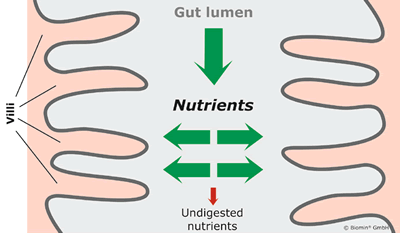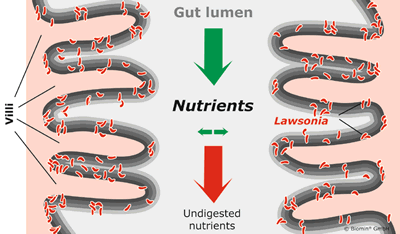Maintaining gut health for top pig performance
In recent years it has been elucidated that a healthy gut is the most important precondition for transforming nutrients into performance. Feed additives such as acidifiers, probiotics and phytogenics are able to influence gut health. Among these feed additives, butyric acid is of particular importance. There are several products on the market providing salts of butyric acid in protected and unprotected forms. Due to the unpleasant persistent odour of butyric acid, protection makes the handling of the product easier. Another reason for protection is to obtain stomach by-pass of butyric acid and subsequent release of the active substance in the small intestine. Encapsulation of acids is a known form of protection.
Beneficial protection
There is also an innovative, beneficial protection in the form of glycerides which is a chemical compound of acids and glycerol. The glycerol-acid compound is not influenced by the pH level or digestive enzymes of the stomach; therefore these compounds reach the small intestine where the gradual release of the undissociated acids through the action of lipases takes place. In nature butyric acid glycerides are found in the milk of cows, sows and other species.
It is known that protected butyric acid is an excellent growth promoter as it is an efficient nutrient for the intestinal mucosa increasing the density and length of villi and enlarging the absorptive surface of the intestine. Butyric acid is also known as an antibacterial agent against pathogenic microorganisms, including salmonella, clostridia, Escherichia coli and brachyspira, and as modulator of the intestinal flora supporting useful micro-organisms such as lactobacilli. Butyric acid enhances the reparation of gut wall lesions caused by intestinal diseases and nutritional imbalances.
The effect of butyric acid glycerides was tested on a commercial farm in Italy, which had problems with ileitis, caused by Lawsonia intracellularis. Figs. 1-3 show the difference between a healthy gut and a subclinical or chronic form of ileitis.
The alteration of intestinal mucosa due to Lawsonia intracellularis can lead to impaired feed conversion and weight gain, as well as poor group uniformity.
The trial was carried out on 70 day old fattening pigs for 63 days on a commercial farm in Italy with 850 Danbred sows. Some 1,025 pigs were divided into two groups. Both groups received lincomycin and doxycycline for the first 14 days. One group received 0.2% lincomycin and commercial acidifier at 0.3% inclusion rate, whereas the other group received the dietary supplementation with glycerides of butyric acids at an inclusion rate of 0.2%.
During the trial, blood and faeces were analysed to detect the presence of Lawsonia intracellularis. The Lawsonia antibodies were detected in blood of both groups. In faeces the control and treated groups were negative to Lawsonia except for one positive 60 days after the beginning of the trial.
The hematic analysis proved that it was impossible to eradicate Lawsonia from both the antibiotic and the glycerides group but it was possible to maintain animal performance.
Increased resistance
The increased resistance to the infection by the piglets receiving glycerides of butyric acid can be attributed to:
- Better gut and mucosa development.
- Increased capacity of repairing lesions caused by pathogens.
- Microflora control.
A commercial product, Biotronic GutPower, is the combination of butyric, caprylic and capric acids in the protected glycerides form. Glycerides allow all acids to act as an antibacterial in the intestine, and furthermore caprylic and capric acids show very strong antimicrobial activity in the higher pH value of the intestine.
In addition, glycerides containing butyric acid and medium chain fatty acids possess nutritional value which is especially important for young animals.
Medium-chain fatty acids, which are saturated fatty acids mainly composed of 8-10 carbon units (caprylic and capric acids), have unique nutritional characteristics different from those of long-chain fatty acids. Medium-chain triglycerides (MCT) are more readily digested and absorbed than long-chain triglycerides (LCT) and easily utilised as energy.

Fig. 1. Sectional view of a healthy gut. Healthy intestinal mucosa and efficient nutrient uptake.

Fig. 2. Subclinical Ileitis. Decreased nutrient resorption due to swelling of intestinal mucosa.

Fig. 3. Ileitis. Loss of functionality of gut mucosa due to massive swelling.
Austrian trial
The efficacy of glycerides of butyric, caprylic and capric acids was tested in a trial carried out with weaned pigs in Biomin's Center of Applied Animal Nutrition in Austria. Some 60 weaned piglets (Landrace x LargeWhite x Pietrain) were divided into two groups with three replications (30 animals per group) that were homogeneous for weight and sex.
One group received the diet containing no growth promoting feed additive, whereas the other group received the dietary supplementation with glycerides of butyric, caprylic and capric acids at an inclusion rate of 1kg/ton feed for the starter period and 0.5kg/t feed for the grower period.
The dietary supplementation with glycerides of butyric, caprylic and capric acids improved animal growth performance as can be seen in Table 2. The final body weight and ADWG were increased by 2.4 and 3.7%, respectively, whereas feed conversion rate (FCR) decreased by 3.3% in the trial group compared to these in the control group (Table 2).
The feed intake was almost at the same level for both groups. Although the differences between the groups were not significant, the results are substantial due to the very high performance level of the animals in both groups.
Optimising gut health is a key to improving animal performance. Animals need support to develop and maintain a healthy microflora in their intestinal tract. Butyric, caprylic and capric acids strengthen the intestine and therefore improve animal performance and protect the gut against the effects of pathogens.
| Table 1. Effect of butyric acid glycerides on growth performance in pigs. | ||
Positive Group |
Butyric Acid glycerides |
|
| Number of animals | 510 |
515 |
| Age at trial beginning, days | 70 |
70 |
| Weight at trial beginning, kg | 25 |
25 |
| Final average weight at day 134, kg | 63.15 |
64.35 |
| Daily weight gain, kg | 0.591 |
0.614 |
| FCR during trial | 2.78 |
2.64 |
| Mortality | 4 |
2 |
| Culls | 3 |
2 |
| Table 2. Effect of butyric, caprylic and capric acids on growth performance in piglets under sub-optimal conditions. | ||
Control |
Glycerides of butyric, caprylic and capric acids |
|
| Initial weight, kg | 8.53 |
8.51 |
| Final weight, kg | 28.91 |
29.61 |
| ADWG, g | 484 |
502 |
| Feed intake (g/animal/day) | 903 |
904 |
| FCR | 1.86 |
1.80 |
| Mortality | 1 |
0 |
| ROI | 4.6:1 |
|












 BIOMIN Holding GmbH
BIOMIN Holding GmbH +43 2782 803 0
+43 2782 803 0






